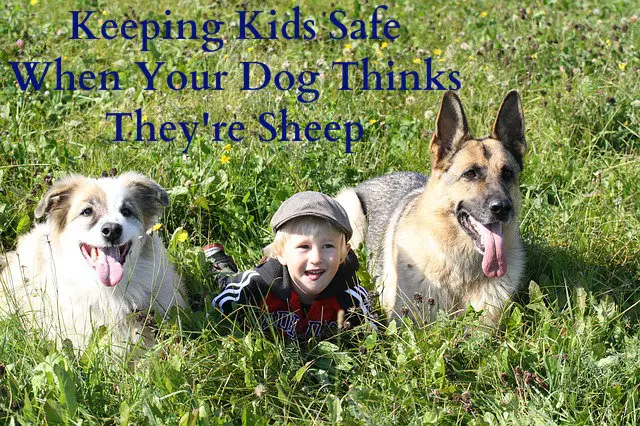Keeping Kids Safe When Your Dog Thinks They’re Sheep
Keeping Kids Safe When Your Dog Thinks They're Sheep
Does your dog think children are sheep? Mine did! Our first dog, JJ, a Sheltie/Shepherd mix (we believe) would circle around my kids nipping at their heels, especially when they were running around. Fortunately, he was super sweet and just following his natural herding instincts, but we realized that we needed to learn about safety around dogs to keep the kids safe. Parenting a herding breed may require an extra dose of diligence, stimulation and exercise to keep him calm and focused. Let’s start with a few suggestions for keeping kids safe around dogs, with the added bonus of being enjoyable and good for your dog.
Training Your Dog
First of all, it is highly recommended that you start out your dog parenting relationship with some basic training, and it’s never too late to start!
Training your dog:
- Teaches him basic commands.
- Teaches what you expect of him in your family and home.
- Gives you and your dog an opportunity to bond.
- Helps socialize him (in a group class).
- Helps him feel safe because there is a natural hierarchy and they learn that you are in charge.
When dogs feel threatened, there is greater potential to act aggressively or skittishly - both undesirable behaviors.
Basic training can lead to more advanced training, as well as the opportunity to participate in more stimulating activities. Further, through training, you can develop a relationship with a trainer in case other issues arise since they will know your dog’s temperament.
Exercising Your Dog
Secondly, making sure your dog, especially any herding breed, is properly exercised is of utmost importance. For some dogs, a nice long walk, or even throwing a ball or Frisbee is sufficient. For others, engaging in more mentally stimulating activities, like agility or nose work is required.
An exercised and satisfied dog is less likely to tear apart your home. Plus, if you have kids, when it’s their turn to play, your dog can be in a crate or on a leash tie out or behind a baby gate so that the kids are safe, and you won’t feel guilty that you are neglecting your dog. Everybody gets their turn to play. I am not a trainer, so please, always consult a professional for proper training and crate training advice.
Teaching Kids How to Behave Around Dogs
Lastly, teach kids how to behave around dogs. Dogs don’t know the difference between adults and kids. Kids have a different energy and their movements are less predictable and that can be threatening or stimulating to dogs. Plus kids are closer to the ground, more like sheep! It’s no wonder our dog JJ loved nipping at the kids’ heels, but didn’t bother the adults.
Here’s an excerpt from the Safety and Bite Prevention section in my book, What to Expect When Adopting a Dog.
A good and accessible resource I’ve found for child safety around dogs comes from Leah Hatley and Justine Schuurmans of TheFamilyDog. They offer videos that teach in a fun and approachable way.
“Unfortunately kids and dogs don’t come just ‘knowing’ the right way to behave around each other. So you can’t just ‘supervise’ and hope for the best - you have to TEACH TEACH TEACH! And to be fair - most parents really want to get it right. The problem is that often all the focus is on the dog instead of training the kids too.
The family dog has a much better shot at success when parents take the time to teach their kids the ground rules and how to understand dog body language too. Acting kindly and respectfully will help them stay safe and have fun with ALL dogs – starting with their own. Less tolerant dogs are everywhere and unfortunately they don’t come with big red flags.
Scarily enough, 77% of bites come from family or friends’ dogs. So if kids are practicing the right things at home there’s a WAY better chance they’ll just naturally do what it takes to stay safe with ANY dog they meet. That’s why we created stopthe77.com, a fun, educational website that has everything parents need to teach their kids how to live happily and safely with dogs.”
—Leah Hatley and Justine Schuurmans, APDT and CPDT-KA certified trainers and Founders, The Family Dog.com
Safety is a top priority for the whole family. Everyone in your house should know proper etiquette and basic handling techniques to help ensure their safety as well as the dog’s. Training in a group or private setting is invaluable. Here are a few safety basics:
At Home
- Avoid leaving your (older) children alone at home with your new dog until both parties are well acquainted and mature enough.
- Teach children to be aware of signs that a dog is stressed.
- Children, especially small children, shouldn’t run around dogs, as the dog could be frightened or even mistake them for prey.
- Children should not pull tails, poke or hit any dog.
- Avoid approaching dogs from behind so as not to surprise them.
Out and About
- When out and about, always ask permission before petting another dog.
- Any unfamiliar dog should always be on a leash.
- Before attempting to pet a new dog, allow them to express an interest in meeting you.
- Ask where the dog prefers to be pet. Many dogs don’t like being pet on the head because they can’t see your hand, which can be frightening for them.
- Remind children that even though their dog is friendly at home, a dog they’ve never met might not be as friendly.
- If the person with that dog says it’s not a good idea to pet their dog, please respect their wishes.
- Teach children to stand still like a tree if a dog gets loose and runs toward them.
- Children should never approach a dog who is in a car or tied up. When restrained, the fight or flight instinct kicks in and they could become aggressive.
Every dog is capable of biting, but with proper socialization, training (people and dogs!) and exercise, you can minimize the chances. There are many reasons why a dog might bite, such as fear or injury. Here are a few more resources to aid you in dog bite prevention. Browse the links and see which works best for you! DoggoneSafe and ASPCA: Dog Bite Prevention
We love our dogs and we love our kids, and the goal is for everyone to live together happily and safely. Train and exercise your dogs and teach children how to behave around dogs inside the home and then how to act around dogs outside of the home. Keeping our kids safe ensures that growing up with a dog is not only a positive experience, but potentially a profound bonding experience with a sweet furry soul who offers us unconditional love.
Article By:
Diane Rose-Solomon
Diane Rose-Solomon is a Certified Humane Education Specialist, the founder of Team Kindness and the award- winning author of children’s books JJ The American Street Dog and JJ Goes to Puppy Class. She is also the author of the non-fiction title, What to Expect When Adopting a Dog .







